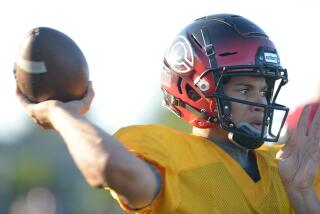Physical Education Instructor Delights in Constant Change
- Share via
TUSTIN — Shirley Sperrazza has been teaching physical education for 36 years and never tires of the constant change she sees among her students.
“I teach at the high school level, which is a very important time in a kid’s life. I hope to provide some lasting influence over their self-esteem and accomplishments,” Sperrazza said.
In fact, it was her former high school physical education instructor who inspired her to become involved in athletics. “It was my senior year and she had a good influence on me,” she said. “I decided to go on to college and get a physical education degree.”
Sperrazza, 57, began teaching on the junior high level, and is now head of the physical education department at Tustin High School. She also coaches the school’s tennis team.
A lot has changed in physical education since Sperrazza started. Most of the classes are now coeducational, where before there were separate classes for boys and girls. There is also a lifelong approach to fitness education, instead of just teaching youngsters about games and rules.
“But we still emphasize games because teens like to compete,” Sperrazza said. “We try to provide a mix of activities and I like having the boys involved.”
Sperrazza would like to see more female physical education instructors and coaches at junior highs and high schools.
“It’s very hard sometimes for women to get established in coaching, because of the age-old conflict between career and family,” she said. Women who want to raise a family find it hard to put in the extra hours it takes to build a reputation.
“The win-loss column is very important in getting jobs, but so are one’s own children,” said Sperrazza, who does not have children. “Still, women are needed in this field.”
HOT JOB
OCCUPATION: Physical education instructor/coach
* What’s involved: Teaching sports and fitness activities in public and private schools. Most play a dual role, teaching physical education classes during school hours and coaching teams in the late afternoon and early evening.
* Qualifications: At least a bachelor’s degree and a teaching credential. Additional certification is required for each sport coached.
* Outlook: By 1998, the number of jobs is projected to increase 7.5% to 5,280.
* Salary range: $25,000-$50,000 per year, depending on education and experience.
* Pros: Those in the field report satisfaction from motivating youngsters, teaching them to set goals for their physical accomplishments and seeing them achieved. Some say that, compared to the classroom, a closer relationship to students is possible in a physical education setting.
* Cons: Team coaching requires additional hours to organize teams, attend practices, conduct workshops and commute to and from games, which are often held during evening and weekend hours. In addition to longer hours, coaches must gain experience and establish a reputation before they can command higher pay.
* Advancement: Some physical education instructors/coaches become department heads or advance to other administrative positions. Some go on to college-level athletics after establishing a reputation.
* Quote: “I enjoy working with students, since they are in a constant state of change. There is a huge growth period that takes place between ninth and 10th grade that is fascinating to observe.”
--Shirley Sperrazza, physical education instructor/coach, Tustin High School
Researched by JANICE L. JONES / Los Angeles Times
More to Read
Get our high school sports newsletter
Prep Rally is devoted to the SoCal high school sports experience, bringing you scores, stories and a behind-the-scenes look at what makes prep sports so popular.
You may occasionally receive promotional content from the Los Angeles Times.






